Physical Address
304 North Cardinal St.
Dorchester Center, MA 02124
Similar to tumors of other upper aerodigestive tract sites, most common tumors of the larynx are of epithelial origin:
Most common benign neoplasm is a (squamous) papilloma
Most common malignant neoplasm is squamous cell carcinoma or variant thereof, accounting for greater than 95% of all malignant neoplasms of the larynx
Primary tumors of the trachea are rare and ratio of benign to malignant tumors varies per age of the patient:
In pediatric ages benign tumors > malignant tumors:
60% to 90% of tumors are benign:
Most common are squamous papillomas, hemangioma, granular cell tumor
10% to 40% are malignant:
Most common is mucoepidermoid carcinoma
In adult ages malignant tumors > benign tumors:
90% of tumors are malignant:
Most common (95% of total) are squamous cell carcinoma and its variants
Most common benign neoplasm is a (squamous) papilloma
For more detailed discussion on a variety of factors related to laryngeal and tracheal carcinoma, see later in this chapter under site-specific squamous cell carcinoma.
Benign
Epithelial
Papilloma/papillomatosis (recurrent respiratory papillomatosis)
Minor salivary gland tumors
Mesenchymal/Neuroectodermal
Granular cell tumor
Nodular fasciitis
Inflammatory myofibroblastic tumor
Chondroma
Rhabdomyoma
Hemangioma
Neurilemoma/neurofibroma
Leiomyoma
Fibrous histiocytoma
Lipoma
Paraganglioma
Others
Premalignant Epithelial Lesions
Dysplasias, keratinizing and nonkeratinizing
Malignant
Epithelial
Squamous cell carcinoma:
Carcinoma in situ
Microinvasive carcinoma
Invasive squamous cell carcinoma
Papillary (exophytic) squamous cell carcinoma
Verrucous carcinoma
Spindle cell squamous carcinoma
Basaloid squamous carcinoma
Adenosquamous carcinoma
Lymphoepithelial-like carcinoma
Giant cell carcinoma
Minor salivary gland tumors:
Adenoid cystic carcinoma
Mucoepidermoid carcinoma
Others
Neuroectodermal
Neuroendocrine carcinomas:
Carcinoid tumor
Atypical carcinoid tumor
Small cell undifferentiated neuroendocrine carcinoma
Large cell neuroendocrine carcinoma
Mucosal malignant melanoma
Mesenchymal
Chondrosarcoma
Synovial sarcoma
Liposarcoma
Rhabdomyosarcoma
Angiosarcoma/Kaposi sarcoma
Leiomyosarcoma
Hematolymphoid
Others
Secondary Tumors
Definition: Benign, exophytic epithelial neoplasm composed of branching fronds of squamous epithelium with fibrovascular cores that may be single or multiple and may be associated etiologically with low-risk human papillomavirus types 6 and 11.
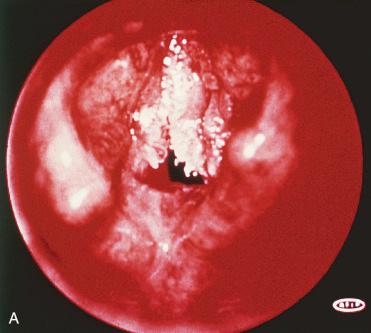
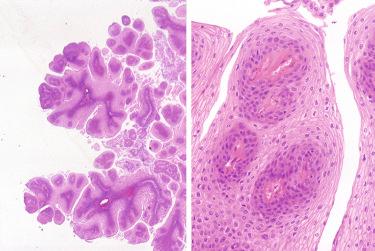
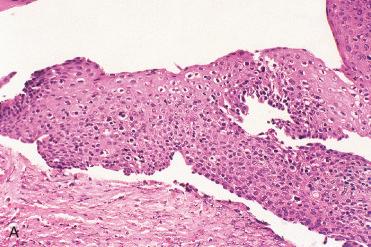
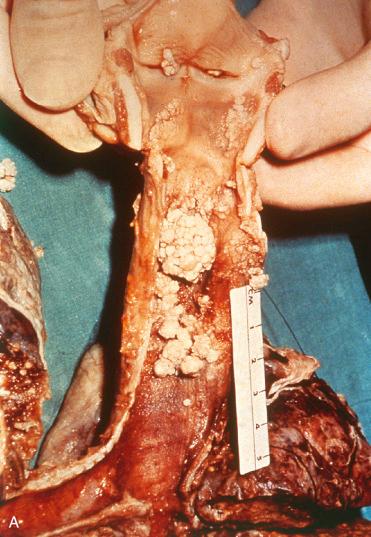
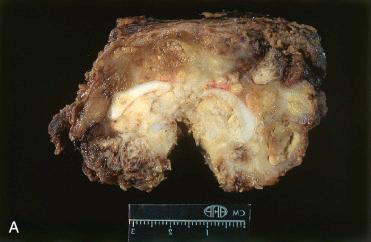
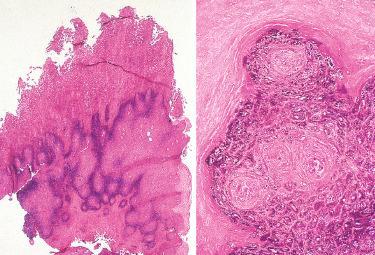
Synonyms: Squamous papilloma; laryngeal papillomatosis; recurrent respiratory papillomatosis, juvenile papillomatosis, adult papillomatosis; nonkeratinized papilloma; keratinized papilloma; papillary keratosis
At present, the preferred terminology for viral-associated papillomas that are nonkeratinizing, tend to persist or recur, and show a degree of resistance to treatment is recurrent respiratory papillomatosis.
Most common benign neoplasm occurring in this anatomic region
Due to distinct clinical and histopathologic findings, papillomas can be separated by:
Age: juvenile versus adult forms
Number of lesions: solitary versus multiple
Histology: nonkeratinizing and keratinizing
Divided into:
Lesions that occur in early years referred to as juvenile-onset recurrent respiratory papillomatosis (JO-RRP)
Lesions that occur in older ages referred to as adult-onset recurrent respiratory papillomatosis (AO-RRP)
Age separating juvenile versus adult onset not established and different studies cite different ages
Although not universally accepted, 20 years of age can serve as a potential dividing line between JO-RRP and AO-RRP.
| JO-RRP | AO-RRP | Keratinizing Papilloma | |
|---|---|---|---|
| Age | Less than 20 years * | 20 years and older * | Occurs in adults |
| Gender | No gender predilection | Much more common in men than in women | No gender predilection |
| Symptoms | Changes in phonation, stridor, dysphagia, cough | Hoarseness | Hoarseness |
| Sites | SCJ includes supraglottic-glottic junction or glottic-subglottic junction | SCJ includes supraglottic-glottic junction or glottic-subglottic junction | True vocal cord is the most common location |
| Lesions | Majority are multiple (80% to 98%) | Majority are single (65% to 75%) | Usually single |
| Pathology | Papillary fronds of multilayered benign squamous epithelium containing fibrovascular cores with little or no keratin | Papillary fronds of multilayered benign squamous epithelium containing fibrovascular cores with little or no keratin | Papillary fronds of multilayered benign squamous epithelium containing fibrovascular cores with associated keratinization (parakeratosis or orthokeratosis); kerato-hyaline granules may be present |
| HPV | Present usually 6 and 11 rarely high-risk types | Present usually 6 and 11 rarely high-risk types | Absent |
| Treatment | Surgical excision | Surgical excision | Surgical resection |
| Prognosis | Variable often with recurrent disease | Variable | Usually cured after excision |
| Malignant transformation | 2% in nonirradiated cases 14% irradiated cases |
2% in nonirradiated cases 14% irradiated cases |
Rare |
No gender predilection; most patients become symptomatic at an early age, including 2 to 5 years of age.
Clinical presentation includes changes in phonation (e.g., abnormal crying, hoarseness), dyspnea, cough, dysphagia, stridor.
Majority are multiple (rather than a single lesion) with extensive growth and rapid recurrence:
May remit spontaneously or persist into older ages
More common in men than in women; affects all age groups but most common from ages 20 to 40
Clinical presentation includes changes in phonation (e.g., hoarseness).
Majority are single (rather than multiple) and tend to recur less often.
Primarily a disease of the larynx:
May occur anywhere in the larynx but most often involve the true and false vocal cords, ventricles, and subglottis
Spread to nearby (extralaryngeal) areas may occur and include oral cavity and tracheobronchial tree:
Extralaryngeal spread occurs more commonly in children than in adults.
Extension into and down tracheobronchial tree occurs in approximately 5% of patients.
RRP tends to localize to those junctional areas where ciliated respiratory epithelium meets squamous epithelium referred to as squamous epithelial-ciliary respiratory epithelial junction (SCJ) and include:
Histologically normal junctional mucosa (e.g., supraglottic-glottic junction or glottic-subglottic junction)
Areas in which there is metaplastic alteration secondary to an injury with squamous epithelium replacing ciliated respiratory epithelium creating a new squamous epithelial-ciliated respiratory epithelial junction
Cause:
Virally induced caused by low-risk human papillomavirus (HPV)
HPV types 6 and 11 most frequent types identified:
Rarely, HPV 16, 18, 31, 33, and 35 identified
Mode of transmission:
In JO-RRP a significant percentage of patients (up to 70%) born to women with uterine cervical condylomas with transmission related to maternal-genital infection:
JO-RRP has been correlated to the triad of (1) first-born child, (2) vaginal delivery, and (3) teenage mother.
Vaginal condyloma in pregnancy is strongly predictive of JO-RRP.
Cesarean section rather than vaginal delivery has been advocated in this clinical setting but cesarean section has not been entirely protective from infection and the development of RRP.
In AO-RRP the mode of transmission remains uncertain; considerations include:
Possibility of maternal transmission during delivery with the virus remaining dormant until adulthood when there is activation of virus
Orogenital contact with an infected individual
Single or multiple exophytic, warty, friable, tan-white to red growth(s)
Characteristic feature is ease of bleeding after minor trauma.
Papillary fronds of multilayered benign squamous epithelium containing fibrovascular cores
Little or no surface keratin production although an occasional case may have keratinization (parakeratosis or orthokeratosis)
Stroma well vascularized; variable amount of inflammatory cells are present
A certain degree of cellular atypia may be seen especially in those lesions that recur over short periods of time:
Generally the degree of dysplasia is limited and the risk of progression to a more significant dysplastic lesion or carcinoma is low.
Atypical features include basal zone hyperplasia with nuclear pleomorphism, increased nuclear-to-cytoplasmic ratio, loss of cell polarity, prominent nucleoli, and increased mitotic activity; dyskeratosis may also be identified.
Presence of severe atypia may be indicative of the development of squamous carcinoma arising in papillomatosis or may in fact represent an exophytic squamous cell carcinoma.
In presence of dysplasia majority are positive for low-risk HPV subtypes so that high-risk HPV subtypes do not predispose patients with laryngeal papilloma to dysplasia
Viral-induced changes (i.e., koilocytosis) may be seen.
Immunohistochemistry:
Immunostains for HPV may be positive:
When virus is present majority are HPV 6/11.
p16 typically negative:
Patchy p16 reactivity may be present but such reactivity does not represent positive staining.
Positive staining requires diffuse and strong nuclear and cytoplasmic staining in at least 75% of the lesions.
p53 negative
Cytogenetics and molecular genetics:
Identification of viral antigens or genomes by in situ hybridization and polymerase chain reaction
In situ hybridization for angiogenic growth factor VEGF-A has shown strong expression in the epithelium of squamous papillomas in RRP, as well as strong expression of VEGFR-1 and VEGFR-2 mRNAs by underlying vascular endothelial cells, suggesting a role for VEGF-A in the pathogenesis of RRP.
Verruca vulgaris:
Typically occurs in cutaneous sites
Infrequently occurs in mucosal sites, including lips
Etiologically linked to HPV:
HPV 2 and 4 typically associated with VV of the skin, lips, and oral cavity
HPV 6 and 11 identified in laryngeal VV
Rare lesion of the larynx:
Much more common in men than in women; disease of adults
Most common on the true vocal cord
Hoarseness is the most common symptom.
Exophytic, demarcated warty-appearing white lesion usually measuring less than 1 cm
Histologically similar to verruca vulgaris of the skin and includes:
Verrucoid appearance
Keratosis
Prominent granular cell layer
Coarse and irregular keratohyaline granules
Thin, pointy rete pegs
Presence of koilocytes
Simple excision is curative.
Recurrence may rarely occur.
Verrucous carcinoma
Papillary or exophytic squamous cell carcinoma
Because of the unpredictable nature of disease, which may be characterized by periods of active growth and remission, best mode of treatment and the efficacy of treatment remain uncertain:
Presently recommended treatment for RRP is surgery, including microlaryngeal excision with CO 2 laser surgery
Adjunctive drugs used in treatment with varying success include interferon, various virostatics (e.g., acyclovir, valacyclovir, and cidofovir), and indole-3-carbinol
Vaccination with a quadrivalent vaccine against HPV types involved most commonly in RRP may provide the best hope to prevent severe forms of this disease.
In general, treatment should be as conservative as possible with the primary aims of therapy to include:
Airway maintenance
Voice preservation
Reduction of tumor burden with the goal of disease eradication
Avoidance of tracheotomy:
Tracheotomy may be required to maintain a functional airway in as high as 65% of patients.
On average tracheotomy is required in approximately one third of patients.
If tracheotomy is required, then the maintenance of airway patency and use of the shortest tracheotomy tube are advised.
Complications of surgery may include:
Laryngoceles
Scarring
Stenosis
Arytenoid fixation
Radiotherapy is contraindicated because of its associated complications, including:
Laryngeal destruction, scarring, and laryngeal stenosis and the risk of inducing malignant transformation
16-fold increased risk of developing carcinoma in patients who have been irradiated
Recurrence of tumor is common, requiring long-term and repeated management:
Recurrence correlates with persistence of HPV.
HPV can be identified in nonpapillomatosis mucosa adjacent to the papilloma in as many as 75% of patients:
Identification of HPV in nondiseased mucosa by in situ hybridization and polymerase chain reaction
Variability of disease course is reflected in the unpredictable nature of recurrent tumor:
Some patients experience one or two recurrences over a few-year period followed by spontaneous remission.
Other patients have frequent recurrences over very short periods of time (weeks), necessitating multiple operative procedures.
Other patients may have repeated recurrences over short periods of time and then remain disease free for decades only to have multiple recurrent diseases later in life, necessitating multiple operative procedures.
Appears that patients with RRP are at risk throughout their lives for the possibility of local recurrence
In approximately 80% of patients disease persists for 5 years or longer.
Effect of puberty and pregnancy on the course of disease remains controversial:
In some patients the disease resolves or becomes less aggressive in puberty or pregnancy.
In some patients the disease progresses/becomes more aggressive in puberty or during pregnancy.
Overall mortality rate varies from 2% to 14%:
Extension into the tracheobronchial tree occurs in 2% to 15% and involvement of lower respiratory tract parenchyma is associated with increased mortality rates.
Death may be caused by asphyxiation, superimposed infection, and malignant transformation.
Carcinoma developing in RRP may occur in nonirradiated and in irradiated patients:
Overall incidence of developing carcinoma in nonirradiated patients is 2%.
Overall incidence of developing carcinoma in irradiated patients is 14%.
Carcinoma developing in the setting of RRP is squamous cell carcinoma.
Transformation of RRP to squamous cell carcinoma may:
Be spontaneous, not characterized by histologic progression, through dysplasia over time
Develop through a continuum of dysplasia over time
Transformation to squamous cell carcinoma may result in loss of HPV expression.
Carcinoma developing in RRP may develop in larynx or in the lung.
Laryngeal carcinomas developing spontaneously (i.e., in nonirradiated patients) tend to:
Occur in JO-RRP
Develop decades after disease onset
Have lower mortality rates
Laryngeal carcinomas developing in irradiated patients tend to:
Occur in JO-RRP
Develop in shorter interval periods (decade or less) after disease onset
Have higher mortality rates
Lung carcinomas developing in nonirradiated and nonsmoking patients tend to:
Have early onset of RRP ranging in age from 1 to 6 years with an average age of onset of ![]() years
years
Have disease extension down the tracheobronchial tree into the lungs
Develop carcinoma approximately 25 years after laryngeal disease
Often have metastatic disease (regional lymph nodes and distant)
Have high mortality rates usually over short periods of time following the diagnosis of carcinoma
Factors in RRP reported to be associated with increased risk of aggressive behavior with spread to lower airway passages, malignant transformation, and death include:
Patients with HPV type 11:
Malignant transformation reported solely for HPV 11–associated RRP in 2% to 4% of all RRP cases
Malignant transformation not reported to be associated with HPV 6; however, a patient with HPV 6 expressing E6 and E7 oncogenes shown to follow similar aggressive clinical course as patients with HPV 11
These patients developed disease at a younger age and expressed higher levels of E6 and E7 oncogenes compared with the patients with more indolent course.
Alterations of aldo-keto reductase 1C3 gene (AKR1C3) on chromosome 10p15.1 may be implicated in carcinogenesis.
Severity score of greater than 4:
Includes functional assessment of clinical parameters and an anatomic assessment of disease distribution
Anatomic score can then be used in combination with the functional score to measure an individual patient's clinical course and response to the therapy over time.
A high number of surgical procedures prior to interferon-alpha therapy
No gender predilection; disease of adults but may occur over a wide age range, including patients younger than 50 years of age
Tend to occur on the true vocal cord
Patients usually present with hoarseness.
Cause:
Not etiologically linked to human papillomavirus (unlike nonkeratinizing papillomas)
Reported to occur in patients with smoking history
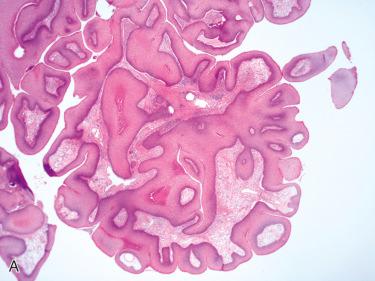
Exophytic or papillary lesion with a white appearance, usually does not exceed 2 cm in greatest dimension.
Papillary fronds of multilayered benign squamous epithelium containing fibrovascular cores with associated keratinization
Keratinization may be in the form of parakeratosis or orthokeratosis.
Keratohyaline granules can be identified.
In most examples there is an absence of cytologic dysplasia (i.e., keratinizing papilloma or papillary keratosis without dysplasia):
Dysplasia can be seen ranging from mild to moderate to severe and should be reported as such (i.e., keratinizing papilloma or papillary keratosis with mild, moderate, or severe dysplasia).
In general, a high threshold should be maintained to diagnose dysplasia because laryngeal papillomas in general and squamous papillomas of the entire upper aerodigestive tract tend to be resistant to developing high-grade intraepithelial dysplasia (i.e., moderate to severe dysplasia).
A variable mixed inflammatory cell infiltrate may be present in the stroma.
Verrucous carcinoma
Papillary or exophytic squamous cell carcinoma
Surgical resection is usually curative.
Usually do not recur but occasionally may recur
Rarely undergo malignant transformation to a carcinoma
Laryngeal benign salivary gland tumors are extremely rare:
Laryngeal malignant salivary gland tumors are more common than benign ones.
Most common tumor type is pleomorphic adenoma.
Most often occur in supraglottic larynx
Histology is identical to pleomorphic adenomas of more common locations (i.e., salivary glands).
Another category of salivary gland lesions include oncocytic papillary lesions:
Controversial category
Various designated oncocytic cyst, oncocytic papillary cystadenoma
Likely do not represent true neoplasms but metaplastic reaction
See Chapter 15 under Laryngeal Cyst for a more complete discussion.
Benign mesenchymal tumors of the larynx and trachea are rare.
In this category, tumor types include:
Hemangiomas
Benign peripheral nerve sheath tumors (neurilemoma; neurofibroma), including granular cell tumor
Lipoma
Paraganglioma
Leiomyoma (conventional leiomyoma, vascular leiomyoma, and epithelioid leiomyoma)
Chondroma
Rhabdomyoma
Giant cell tumor (osteoclastoma)
For more complete discussion of some of these tumor types see other sections.
This section includes discussion of the following lesions: inflammatory myofibroblastic tumor, granular cell tumor, lipoma, paraganglioma, and chondroma.
Definition: Distinctive lesion composed of myofibroblastic and fibroblastic cells with a variable admixture of inflammatory cells, including mature lymphocytes, plasma cells, and/or eosinophils.
Predominantly soft tissue and visceral tumor that may occur in mucosa of upper aerodigestive tract
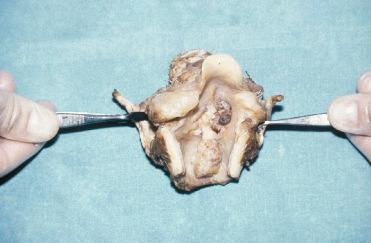
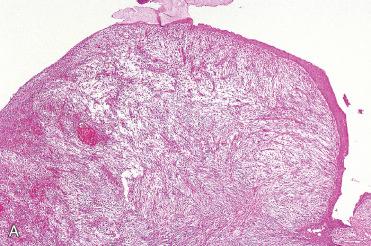
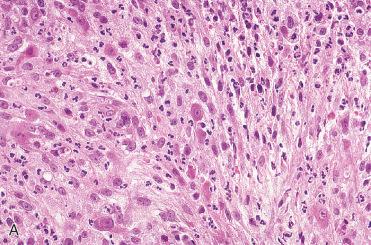
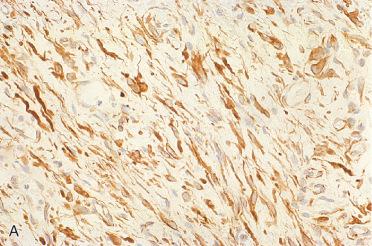
Synonyms: Inflammatory (myofibroblastic) pseudotumor, plasma cell granuloma, plasma cell pseudotumor, pseudosarcomatous (myofibroblastic) lesions/tumors
IMT of upper aerodigestive tract are rare:
Aside from scattered case reports there are very few comprehensive studies detailing the clinicopathologic features of IMT in upper aerodigestive tract sites.
Male predominance; contrasting to soft tissue and visceral IMT, which occur predominantly in children and young adults, IMT of the upper aerodigestive tract occur over a wide age range that includes the pediatric population but is more common in adult populations:
Relative to laryngeal IMT, median age of 59 years reported
In upper aerodigestive tract, IMT most commonly occur in the larynx:
Laryngeal sites of involvement include glottis, supraglottis, and subglottis.
Most common site of occurrence is the true vocal cord
Nonlaryngeal sites of occurrence include oral cavity, tonsil, parapharyngeal space, sinonasal tract, salivary glands, and trachea.
Clinical presentation varies per site of occurrence:
Larynx: hoarseness, stridor, dysphonia, and/or a foreign body sensation in the throat; duration of symptoms range from as short as 10 days up to 4 months
Other aerodigestive tract sites may present as painless mass, ulcerative painful mass, nasal obstruction, epistaxis, headaches, and dysphagia.
Constitutional and/or systemic signs and symptoms such as fever, weight loss, pain, malaise, anemia, thrombocytosis, polyclonal hyperglobulinemia, and elevated erythrocyte sedimentation rate seen in association with soft tissue and visceral IMT are not usually a component of upper aerodigestive tract IMT. High fever, anemia and weight loss may be present.
IMT of the upper aerodigestive tract present as solitary (isolated) lesions, typically without lesions of other upper aerodigestive tract sites or evidence of myofibroblastic lesions of other sites of the body.
Cause of IMT in general and upper aerodigestive tract in specific is unknown:
No specific link to tobacco smoking, trauma (e.g., traumatic intubation), human herpesvirus-8 (HHV-8), or Epstein-Barr virus (EBV)
Polypoid, pedunculated, or nodular firm lesion with a smooth appearance and fleshy to firm consistency
Range in size from 0.4 to 3 cm in greatest dimension
Polypoid and unencapsulated characterized by the presence of a submucosal loosely cellular proliferation of spindle-shaped to stellate cells with variably admixed inflammatory cells
Cellular proliferation loosely arranged with a storiform to fascicular growth pattern and an edematous myxoid to fibromyxoid stroma, prominent vascularity, and an inflammatory cell infiltrate composed of mature plasma cells, mature lymphocytes, eosinophils, histiocytes, and scattered polymorphonuclear leukocytes:
Overall appearance is similar to a reactive process resembling granulation tissue and nodular fasciitis.
Primarily spindle-shaped or stellate with enlarged round to oblong nuclei, inapparent to prominent eosinophilic nucleoli, and abundant eosinophilic to basophilic-appearing fibrillar cytoplasm:
In some cases myofibroblasts may appear more epithelioid or histiocytoid, including round to oval nuclei, prominent nucleoli, and ample cytoplasm.
Myofibroblasts may also appear as slender axonal (spider-like) cells with elongated nuclei, inapparent nucleoli, and long cytoplasmic extensions creating cells with a bipolar-to-multipolar (tadpole-like) appearance.
In all their histologic forms myofibroblasts maintain a low nuclear-to-cytoplasmic ratio.
A helpful feature may be the presence of intranuclear eosinophilic inclusions:
Not unique to IMT but represent a rather characteristic feature especially in the context of histologic findings associated with IMT
Focal nuclear pleomorphism may be present; marked nuclear pleomorphism and necrosis not usually present
Mitotic figures are present and may be numerous but atypical mitoses are not usually seen.
Stromal component varies from an edematous myxoid background to fibromyxoid and more fibrous (collagenized); rarely, a fibrillar appearing stroma resembling neurofibrillary matrix may be seen.
Vascular component varies from widely dilated medium-sized vascular channels to narrow, slit-like blood vessels that can be obscured by the myofibroblasts and inflammatory cells; vascular thrombosis not present
Admixture of different cell types, including mature lymphocytes, mature plasma cells, eosinophils, histiocytes, and scattered polymorphonuclear leukocytes:
Degree of inflammatory cell infiltrate may vary from case to case
Prominent mature plasma cell infiltrate may be present:
Previous designation for IMT was plasma cell granuloma.
In conjunction with sclerotic stroma as well as increased numbers of IgG4-positive plasma cell and IgG4/IgG ratio ≥0.10 may suggest a possible diagnosis of IgG4-related disease (see Differential Diagnosis below).
Surface epithelium may be intact and unremarkable to ulcerated to hyperplastic.
Myofibroblastic proliferation may approximate surface epithelium but usually there is a separation between the myofibroblasts and surface epithelium.
Reactive epithelial atypia may be seen but significant epithelial dysplasia (i.e., moderate to severe dysplasia), carcinoma in situ, and invasive squamous carcinoma are not present.
Histochemistry:
Essentially noncontributory to the diagnosis
Immunohistochemistry:
Strong diffuse cytoplasmic immunoreactivity for vimentin
Smooth muscle actin and/or muscle specific actin typically present but may vary from focal to diffuse
Desmin staining may be present.
CD68 may be focal in histiocytic-appearing cells.
Epithelial markers (cytokeratins, EMA, others) typically absent but staining for cytokeratins may be present in up to 33% of cases:
When present cytokeratin staining tends to be focal rather than diffuse.
No immunoreactivity for S100 protein, p63, HMB-45, myoglobin, myogenin (myf-4), MyoD1, CD34, CD117
Reactivity for anaplastic lymphoma kinase (ALK) can be seen corresponding to the presence of ALK rearrangements (see Cytogenetics later):
ALK reactivity is cytoplasmic.
Intranuclear inclusions may be ALK positive.
Wide range of ALK positivity reported varying from 36% to 60% of cases
ALK lacks specificity and sensitivity.
Imperfect correlation to ALK mutations
Different fusion partners (see Cytogenetics later) may result in different patterns of ALK immunoreactivity
Electron microscopy:
IMTS show features of myofibroblastic and fibroblastic differentiation:
Cytoplasmic organelles include well-developed, prominent rough endoplasmic reticulum, Golgi complexes, bundles of microfilaments arranged in parallel along the long axis of the cells with focal densities (“stress fibers”), fragmented basal lamina, pinocytotic vesicles, and fibronexus junctions.
Fibronexus junctions represent foci on the cell surface in which intracellular myofilaments and extracellular fibronectin filaments converge.
Rarely, junctional complexes can be seen.
Cytogenetics and molecular genetics:
In children and young adults from 50% to 70% of cases often contain clonal cytogenetic rearrangements involving chromosome band 2p23 that fuse 3′ kinase region of ALK gene with various partner genes including:
TPM3, TPM4, CLTC, RANBP2, and ATIC
Such rearrangements are uncommon in adults >40 years of age.
Rearrangement restricted to myofibroblastic cell component whereas inflammatory cell component is normal without gene rearrangements or expression of ALK protein
Presence of immunohistochemical expression of the ALK C-terminal end in myofibroblastic component of IMT and low to absent detection of ALK protein in nonneoplastic myofibroblasts represent strong evidence for oncogenic activation mechanism in IMT
Contact ulcer of the larynx
Pyogenic granuloma
Nodular fasciitis:
Myofibroblastic dominant proliferation
Typically a lesion of soft tissue but rarely may be mucosal based, originating in mucosal sites of upper aerodigestive tract, including the larynx and pharynx
For a more complete discussion, see Section 4, Neck.
IgG4-related disease:
Although there may be some overlap in histologic findings and presence of increase IgG4 plasma cells between IgG4-related disease and IMT, these two entities have distinct clinical and pathologic findings:
IgG4-related disease is typically systemic but may be localized, whereas IMT are generally localized.
Histologic findings often seen in IgG4-related disease include obliterative phlebitis and lymphoid aggregates, features not seen in IMT.
IgG4-related disease is ALK negative.
IgG4-related disease responds to steroid treatment.
For a more complete discussion of IgG4-related disease see Section 6, Salivary Glands.
Spindle cell squamous carcinoma:
Overtly malignant cell infiltrate that may be associated with intraepithelial dysplasia and/or invasive squamous cell carcinoma
Reactivity may be seen for epithelial markers (cytokeratins, others) and p63.
Consistently reactive for vimentin and may be reactive for mesenchymal markers including actins and desmin
ALK negative
Spindle cell squamous carcinomas, especially those with associated surface ulceration and reactive changes, may have coexisting (reactive) myofibroblasts, the latter representing part of the wound healing process.
Myofibrosarcoma
Laryngeal IMT are treated by conservative surgical resection, including local excision by laser removal or via laryngoscopic techniques.
Conservative resection usually curative:
Rarely, recurrent tumor may occur after conservative surgical resection necessitating laryngectomy.
Targeted therapy using ALK inhibitor crizotinib has shown promising results in ALK-translocated IMT
Recurrence rate of approximately 25% has been reported for extrapulmonary IMT.
Rare examples of extrapulmonary (not head and neck) IMT metastasize (less than 2%):
May be linked to presence of RANBP2 and round cell morphology
ALK-negative IMT may have higher risk of metastasis.
Difficult to predict on the basis of pathologic features which IMTs may behave more aggressively:
No correlation between behavior and tumor size, nuclear atypia, mitotic activity, necrosis
Aggressive behavior may correlate to round cell transformation characterized by:
Sheets of round to epithelioid cells with vesicular nuclei, prominent nucleoli, amphophilic to eosinophilic cytoplasm, increased mitotic activity including atypical mitoses, myxoid stroma, and prominent neutrophilic infiltrate
Distinct nuclear membrane or perinuclear pattern of ALK staining
RANBP2-ALK fusion detected by reverse transcription polymerase chain reaction
To date, such changes reported in IMT located within the abdomen arising from omentum or mesentery
Terminology of epithelioid inflammatory myofibroblastic sarcoma suggested for this lesion conveying malignant behavior
Definition: Benign tumor of neurogenic (Schwann cell) origin characterized by lysosome-rich cells with abundant granular eosinophilic-appearing cytoplasm.
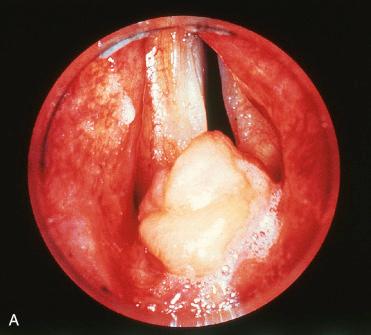
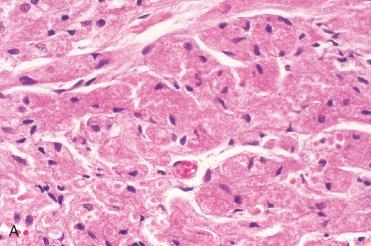
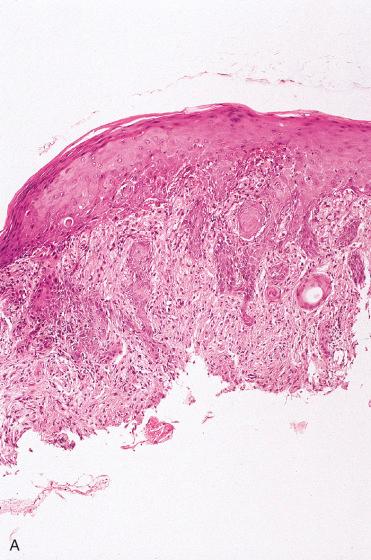
Synonyms: Granular cell myoblastoma; granular cell neuroma; granular cell schwannoma; granular cell neurofibroma; Abrikossoff tumor; granular cell schwannoma
Two forms can occur:
Mucosal granular cell tumor
Congenital granular cell epulis (see Section 2, Oral Cavity, for detailed discussion)
Can occur in virtually any organ but most frequent sites of occurrence include:
Skin > tongue > breast > larynx > gastrointestinal tract > bronchus, trachea
Except for the larynx, granular cell tumors are more common in women than in men
See Section 2 on the Oral Cavity for a discussion of lingual granular cell tumor and congenital granular cell epulis.
For laryngeal tumors:
No gender predilection; primarily affects adults in third to fifth decades of life; uncommon in children
Hoarseness is most common complaint.
Most frequently identified along the posterior aspect of the true vocal cord (posterior one third) but can also be seen in the supraglottic and subglottic areas:
Vocal cord > arytenoids > false cord > anterior commissure > subglottis > postcricoid area
For tracheal tumors:
More common in women than in men
Wide age range but peak incidence is in the fourth decade
Symptoms include stridor and airway obstruction.
Most often arise in the cervical trachea
Regardless of site, most GCTs are single lesions but multiple tumors may be found:
May occur synchronously or metachronously
Multiple granular cell tumors may occur in LEOPARD syndrome and Noonan syndrome associated with mutations in PTPN11 .
No known cause
Granular cell tumors felt to be of neural (Schwann cells) origin supported by:
Involvement of small to medium nerves
S100 protein, CD57, and neuron-specific enolase positive
Presence of myelinated and nonmyelinated axon-like structures by ultrastructural analysis
Presence of residual axons in many granular cell tumors
Often solitary, polypoid, or sessile, tan-white to yellow, measuring from 0.3 to 3.0 cm in diameter; occasionally may have papillary or cystic areas
Most are submucosal with an intact overlying surface epithelium, although rarely may be associated with epithelial ulceration.
NOTE: Regardless of location, histology is the same.
Unencapsulated or poorly circumscribed subepithelial lesion with a syncytial, trabecular, or nested growth pattern
Neoplastic cells are round to polygonal with round to oval, vesicular to hyperchromatic, centrally located small nuclei, and the presence of coarsely granular eosinophilic-appearing cytoplasm with poorly delineated cell borders.
Cellular pleomorphism varies but usually is minimal:
Uncommonly markedly pleomorphic nuclei may be present.
Mitoses and necrosis not typically present
Occasionally, within the collagenous tissue and in the proximity of vessels, stromal histiocytes with large refractile needle-shaped bodies may be seen:
Referred to as angulate bodies
Pseudoepitheliomatous hyperplasia (PEH) may be present:
Exuberant epithelial hyperplasia that may be associated with granular cell tumors
May be so exuberant as to suggest a diagnosis of invasive squamous cell carcinoma:
In contrast to squamous cell carcinoma, PEH typically displays no cytologic evidence of malignancy.
However, some examples may be histologically identical to invasive squamous cell carcinoma:
A diagnosis of SCC should not be rendered in the presence of granular cell tumor unless:
Epithelial proliferation extends beyond/below the depth of associated granular cell tumor:
S100 protein and cytokeratins may be needed to determine extent of the epithelial proliferation relative to the granular cell tumor.
Metastatic squamous cell carcinoma (locoregional, distant) is present.
Granular cell tumor cells may involve (“invade”) nerves:
Does not represent an indicator of malignancy (see below for malignant granular cell tumor)
Histochemistry:
Cytoplasmic granules are diastase-resistant, PAS-positive, stain with alcian blue at pH 2.5, stain red with trichrome, and vary in size from being minute to as large as red blood cells.
Angulate bodies are intensely PAS positive.
Immunohistochemistry:
S100 protein, calretinin, CD57 (Leu-7) positive
Strongly CD68 (KP-1) positive as well as alpha-1-antitrypsin and alpha-1-antichymotrypsin
Laminin and collagen type 4 are positive, highlighting basement membranes around groups of tumor cells.
Additional consistent but nonspecific staining seen for inhibin alpha-subunit and protein gene product 9.5:
Significance of inhibin expression with regard to cell differentiation and pathogenesis is unclear.
Proliferative activity as seen by Ki-67 reactivity is low.
Negative for cytokeratins, neurofilament protein, and glial fibrillary acidic protein
Interstitial cells with angulate bodies are CD68 positive and S100 protein negative.
Electron microscopy:
Characterized by presence of numerous intracellular large granules (secondary lysosomes) consisting of membrane-bound, autophagic vacuoles containing mitochondria, rough endoplasmic reticulum, myelin figures, and myelinated and nonmyelinated axon-like structures
Interstitial cells contain membrane-bound structures with parallel arrays of microtubules representing angulated bodies as well as microfilaments and lipid material.
Rhabdomyoma
Invasive squamous cell carcinoma as a result of the PEH
Alveolar soft part sarcoma
Malignant granular cell tumor:
Rare neoplasms accounting for approximately 1% of all granular cell tumors
Clinically are similar to benign granular cell tumors except that they do not occur in newborns or children
Usually measure >4.0 cm in diameter and tend to occur in the extremities
Histologically, a diagnosis of malignancy can be made in the presence of three of the following criteria:
Necrosis
Spindle-shaped cells
Increased nuclear-to-cytoplasmic ratio
Vesicular nuclei with prominent nucleoli
Pleomorphism
Increased mitotic activity (greater than two mitoses per 10 high-power fields)
Any granular cell tumor in which one or two of the above criteria are found can be referred to as atypical.
Transition from benign granular cell tumor to malignant granular cell tumor is frequently apparent.
Immunohistochemical staining similar to that of benign granular cell tumors except:
CEA reactivity reported, significance of which is not known
Increase proliferation rate from 10% to 50% by Ki67 (MIB1) staining
Extensive p53 staining in up to 70% of cases
Differential diagnosis includes alveolar soft part sarcoma and paraganglioma.
Surgery is the preferred treatment (wide en bloc excision); radio- and chemotherapy are ineffective.
Metastasize via lymphatics and blood vessels (lymph nodes, lung, liver, and bone)
Conservative but complete surgical excision is considered curative:
Small tumors can be excised endoscopically.
Granular cell tumors are radioresistant.
Local recurrence may occur in a minority of patients (less than 10%):
Recurrent tumor may represent a new primary lesion in patients with multifocal disease.
Definition: Benign neoplasm arising from the extra-adrenal neural crest-derived paraganglia specifically located in the larynx, and believed to arise from the superior and inferior laryngeal paraganglia.
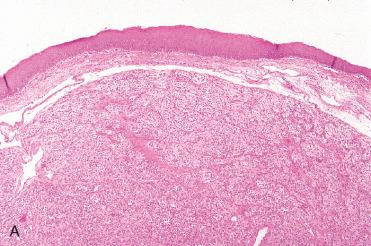
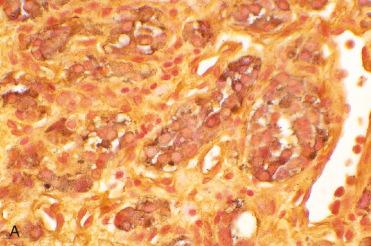
Synonym: Glomus tumor
Laryngeal paraganglia are microscopic structures with variable anatomic distribution in relation to cricoid and thyroid cartilages.
Most are paired structures located in superior and inferior locations in lateral larynx.
Sometimes found immediately adjacent to thyroid gland or within capsule of thyroid gland
Described in relation to laryngeal recurrent nerve
Physiologic role of laryngeal paraganglia unknown
Uncommon laryngeal tumor
More common in women than in men; wide age range but most common in the fifth decade of life
Vast majority (greater than 80%) predilect to the supraglottic larynx with the aryepiglottic fold and false vocal cord representing the most common sites of occurrence.
Clinical presentation includes hoarseness, dysphagia, dyspnea, and stridor.
Generally are not hormonally (functionally) active, although exceptional cases may be functional.
Rarely may be multicentric with other head and neck paragangliomas
Radiology:
CT: enhancing mass
MRI: intermediate signal intensity on T1-weighted image and high signal intensity on T2-weighted image
Submucosal tumors ranging in size from 0.5 to 6.0 cm
Located in submucosa without involvement of overlying intact epithelium
Identical to paragangliomas of more usual sites:
Histologic hallmark is the presence of a cell nest or “Zellballen” pattern cell nest characteristic of paragangliomas.
Stroma surrounding and separating the nests is composed of a prominent fibrovascular tissue
Neoplasm is composed predominantly of chief cells, which are round or oval with uniform nuclei, dispersed chromatin pattern, and abundant eosinophilic, granular, or vacuolated cytoplasm
Sustentacular cells difficult, if not impossible, to identify by light microscopy:
These cells represent modified Schwann cells.
Are located at the periphery of cell nests
Appear as spindle-shaped, basophilic-appearing cells
Glandular or alveolar differentiation is not seen.
Histochemistry:
Reticulin staining may better delineate the cell nest growth pattern with staining of the fibrovascular cores surrounding the neoplastic nests
Tumor cells are argyrophilic (Churukian-Schenk)
Argentaffin (Fontana-Masson), mucicarmine, and periodic acid Schiff stains are negative.
Immunohistochemistry:
Chief cells:
Chromogranin, synaptophysin, CD56, neuron-specific enolase, neurofilaments, and a variety of peptides positive; GATA3 positive (nuclear)
May also be S100 protein positive
Sustentacular cells:
S100 protein positive, Sox10 positive
Vimentin is variably reactive in chief cells and sustentacular cells
In general, epithelial markers, including cytokeratins and p63, are negative:
Rare examples of cytokeratin-reactive paragangliomas are reported.
Melanocytic markers (HMB45, melan-A, tyrosinase, MITF, Sox10) negative
Myogenic markers (desmin, myogenin, others) negative
Electron microscopy:
Abundant neurosecretory granules (100 to 250 nm)
Cellular junctional complexes are rarely (if ever) seen.
Neuroendocrine carcinomas including carcinoid tumor and atypical carcinoid (see Box 16-5 and Table 16-6 )
Surgery is the preferred treatment and is curative.
Malignant paragangliomas reported in the literature more likely represent neuroendocrine carcinoma
Definition: Benign tumor of mature hyaline cartilage.
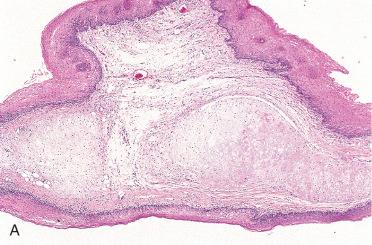
Cartilaginous neoplasms of the head and neck are uncommon, and those of the larynx are rare:
Laryngeal chondrosarcomas are more common than chondromas.
Most common sites of occurrence of head and neck chondromas include:
Sinonasal tract
Less common sites include maxilla and mandible, larynx, palate, pharynx, nasopharynx, and ear.
In the larynx, chondromas may originate from posterior lamina of cricoid cartilage and thyroid cartilage and less often from epiglottis and arytenoids.
May arise in soft tissues of the true vocal cords (Reinke space)
May be incidentally identified or cause hoarseness:
A clinically significant cartilaginous tumor of the larynx is most likely a chondrosarcoma.
Radiology:
Discrete soft tissue mass contiguous with its laryngeal cartilaginous origin
Coarse calcifications and ossification may be seen.
Involvement of Reinke space most probably represents a metaplastic rather than a true neoplastic process with derivation from the vocal cord ligament.
Lobulated, firm to hard, blue-gray, submucosal mass seldom measuring greater than 1 cm:
Although laryngeal chondromas seldom attain sizes greater than 1 cm, occasionally they may grow to sizes up to 4 cm.
Submucosal lobulated or nodular growth(s) composed of chondrocytes recapitulating the normal histology of cartilage.
Absence of cellular pleomorphism, binucleate chondrocytes, or mitotic activity
Immunohistochemistry:
S100 protein positive
Podoplanin (D2-40) positive
Cartilaginous hamartoma
Chondrosarcoma (see later in chapter)
Conservative but wide surgical excision including an adequate margin of normal tissue is the preferred treatment:
Surgical resection is curative.
Recurrences are uncommon and according to most authorities do not occur in association with laryngeal chondromas.
Recurrent chondromas of the larynx should prompt a diagnosis of a low-grade chondrosarcoma.
Definition: Benign tumor of mature adipocytes.
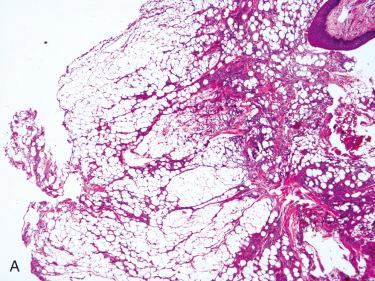
In the head and neck, most often occur in the neck region (see Section 4, Neck, for more complete discussion)
Rare tumor of larynx (and hypopharynx)
More common in men than in women; adult ages usually sixth decade and older
Solitary tumors often arising in the supraglottic larynx or project into the larynx from a hypopharyngeal mass:
Laryngeal sites of occurrence include aryepiglottic fold, vestibular fold, and epiglottis.
Symptoms include dysphagia, dyspnea, acute airway obstruction, hoarseness, dysphonia, and a lump in the throat.
Radiology:
CT scan: low attenuation mass:
Adipose tissue is the only soft tissue that has a density less than water (zero or negative Hounsfield units) so that CT scan reveals extent of the mass and also its lipomatous nature.
No known cause:
Rare cases reported in association with symmetric lipomatosis (Madelung disease or Launois-Bensaude syndrome)
Sessile to pedunculated mass measuring from a few millimeters to 6.0 cm in greatest dimension
Encapsulated tumor of mature adipose tissue (adipocytes):
Adipocytes are uniform, varying slightly in size and shape.
Atypical adipocytes and/or lipoblasts are not identified.
Richly vascularized but vascularity may be difficult to appreciate due to compression by distended adipocytes.
Secondary changes may include hemorrhage, calcification, cyst formation, fat necrosis, and infarction.
Metaplastic bone and cartilage may be identified.
Laryngeal (and hypopharyngeal) lipomas may include:
Lipomas with prominent myxoid stroma (myxolipoma) or prominent fibrous tissue component (fibrolipoma)
Intramuscular lipomas:
Also referred to as infiltrating lipoma
Characterized by the presence of mature adipocytes infiltrating skeletal muscle
Spindle cell lipoma:
Characterized by mature adipocytes admixed with uniform, small spindle cells, and eosinophilic collagen bundles set in a myxoid matrix with a vascular pattern varying from inconspicuous to prominent
Mast cells can be seen in association with the spindle cells.
Other types of lipomas including angiolipoma, pleomorphic lipoma, angiomyolipoma, and lipoblastoma not reported in these sites
Immunohistochemistry (not needed for the diagnosis):
Adipocytes are S100 protein positive.
CD34 positive in spindle cell lipomas
MDM2 and CDK4 negative
Hibernoma (benign tumors of brown fat)
Rare examples reported to occur in the larynx
For conventional lipoma:
Atypical lipomatous neoplasm/well-differentiated (lipoma-like) liposarcoma; see later in chapter.
For myxoid lipoma:
Vocal cord polyp, myxoid type
Myxoid liposarcoma
For spindle cell lipoma:
Various spindle cell neoplasms of these sites
Surgery is curative.
May rarely recur:
May be a function of inadequate excision
Presence of recurrence should raise diagnosis of well-differentiated liposarcoma:
Does not represent transformation from a lipoma but initial lesion was a liposarcoma that went undiagnosed due to overall bland morphology lacking overt evidence of malignancy
In this setting staining for MDM2 and CDK4 may prove useful and diagnostic.
Squamous cell carcinoma or a variant thereof is most common malignant neoplasm of the larynx
See Section 2, Oral Cavity, for a more complete discussion of the following topics related to head and neck squamous cell carcinoma (HNSCC):
Mutagen sensitivity
“Field cancerization”
Second primary malignancy
Genetics of HNSCC
Prognostic indicators, including:
Status of the surgical resection margins
Nodal metastasis
Lymph-vascular invasion
Invasion of soft tissue structures including nerves and cartilage
Distant metastasis
Multiple primary malignancies (second malignancy)
Host immunologic response
Definition: Alteration in a malignant direction in the appearance of epithelial cells with an increased likelihood to progress to squamous cell carcinoma.
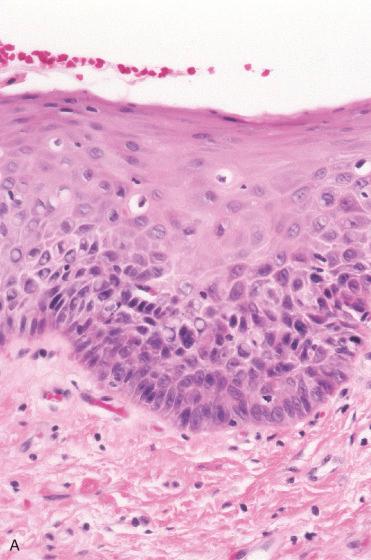
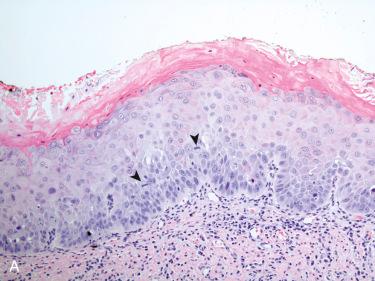
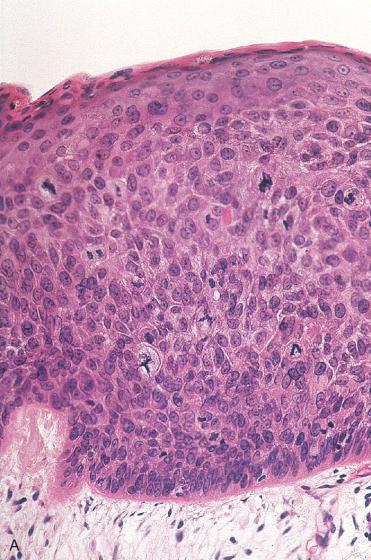
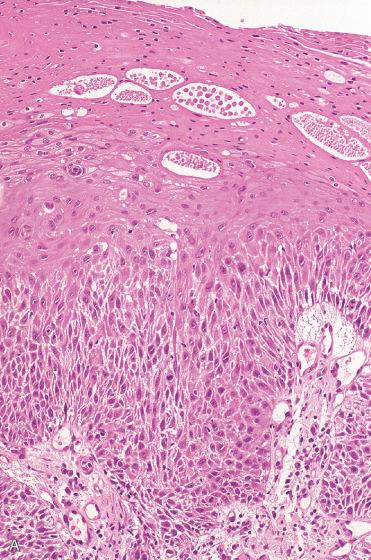
Synonyms: Keratosis with atypia; atypia; mild dysplasia; moderate dysplasia; severe dysplasia; squamous intraepithelial lesion (SIL); squamous intraepithelial neoplasia (SIN); laryngeal intraepithelial lesion (LIN); laryngeal intraepithelial lesion (LIL); simple hyperplasia; basal/parabasal hyperplasia; atypical hyperplasia
Recommended WHO terminology includes mild, moderate, and severe dysplasia and carcinoma in situ ( Table 16-2 ).
| WHO * | SIN | Ljubljana | Modified Ljubljana | Two-Tiered |
|---|---|---|---|---|
| Mild dysplasia | SIN 1 | Basal/parabasal cell hyperplasia | LGSIL | LGSIL |
| Moderate dysplasia | SIN 2 | Atypical hyperplasia | HGSIL | HGSIL |
| Severe dysplasia | SIN 3 | Atypical hyperplasia | HGSIL | HGSIL |
| CIS | SIN 3 | CIS | CIS | HGSIL |
More common in men than in women; generally limited to the adult population with a mean age at diagnosis in the sixth decade of life
May occur anywhere in the larynx but mainly identified along the true vocal cord:
Typically is a unilateral lesion but may be bilateral in up to 30% of cases
Most frequent symptom is hoarseness.
May appear white (leukoplakia), red (erythroplakia), or mixed red and white (speckled leukoplakia):
See Section 2, Oral Cavity, for more complete discussion on leukoplakic and erythroplakic lesions.
Causes may include:
Tobacco smoking (most common) and excess alcohol use:
Alcohol potentiates the effect of tobacco smoking.
Risk of developing dysplastic lesions increases with duration of smoking and/or alcohol use.
Chronic infections, including fungal infection
Less commonly secondary to voice abuse, environmental/industrial exposure, and vitamin A deficiency
Role of human papillomavirus in development of intraepithelial dysplasia of the larynx remains unproven:
High-risk HPV uncommon finding in head and neck squamous cell carcinoma from patients who have history of tobacco or alcohol use
Low-risk HPV not associated with such cases
Prevalence of HPV in precursor lesions (i.e., dysplasia) reported in approximately 12% of cases
HPV DNA reported in 12% to 25% of normal (clinically and histologically) larynges
Localized, circumscribed flat, or papillary area with white (leukoplakic), red (erythroplakic), or gray appearance
Histomorphologic changes can be separated into architectural abnormalities and cellular abnormalities and include proliferation of immature or “uncommitted” cells with process beginning in basal and parabasal area:
Architectural abnormalities:
Irregular epithelial stratification with elongated rete ridges extending in a downward fashion into submucosa
Loss of maturation with increased cellularity in the superficial epithelium:
Normally in mature squamous epithelium there is a decrease in the cellularity from the basal zone toward the keratinizing layers
Paradoxical maturation (abnormal keratinization or keratin pearl formation in the basal zone)
Crowding of cells with loss of polarity especially in the basal zone
Increased mitotic activity, especially away from the basal zone involving the mid- and upper (superficial) portions of the surface epithelium:
May include atypical forms
Abnormal keratosis (dyskeratosis):
Occurs in individual cells
Keratin pearls in elongated rete pegs
Cellular abnormalities:
Abnormal variation in nuclear size (anisonucleosis)
Abnormal variation in the nuclear shape (nuclear pleomorphism)
Increased nuclear size relative to cytoplasm (increased nuclear-to-cytoplasmic ratio)
Nuclear hyperchromasia with irregularities in nuclear contour
Prominent nucleoli (not unique to dysplasia and may be seen in a reactive or reparative process)
Histomorphologic evaluation for dysplasia is primarily predicated on the cellular abnormalities but also include architectural abnormalities especially in relationship to keratinizing dysplastic lesions.
Irregular epithelial stratification with elongated rete ridges extending in a downward fashion into submucosa
Loss of maturation with increased cellularity in the superficial epithelium:
Normally in mature squamous epithelium there is a decrease in the cellularity from the basal zone toward the keratinizing layers.
Crowding of cells with loss of polarity especially in the basal zone
Increased mitotic activity, especially away from the basal zone involving the mid- and upper (superficial) portions of the surface epithelium:
May include atypical forms
Abnormal keratosis (dyskeratosis) and paradoxical maturation:
Occurs in individual cells
Keratin pearls in elongated rete ridges
Abnormal variation in nuclear size (anisonucleosis)
Abnormal variation in the nuclear shape (nuclear pleomorphism)
Increase nuclear size relative to cytoplasm (increased nuclear-to-cytoplasmic ratio)
Nuclear hyperchromasia with irregularities in nuclear contour
Prominent nucleoli (not unique to dysplasia may be seen in reactive or reparative processes)
Grading of upper aerodigestive tract intraepithelial dysplasias is controversial and fraught with subjectivity especially for keratinizing dysplasias.
Variety of grading schemes proposed (see Table 16-2 ) but at present the recommended classification scheme is three-tiered system of grading intraepithelial dysplasias advocated by the World Health Organization to include:
Mild dysplasia (grade I):
Dysplasia limited to the lower portions or inner third of the epithelium (basal zone dysplasia)
Moderate dysplasia (grade II):
Dysplasia involves up to two thirds of the thickness of the epithelium.
Severe dysplasia (grade III):
Dysplasia involves from two thirds to almost complete thickness of the epithelium.
Carcinoma in situ is subsumed within this grade.
Two-tiered system of grading intraepithelial dysplasias (see Table 16-2 ) is advocated to include:
Low-grade squamous intraepithelial dysplasia includes mild dysplasia.
High-grade squamous intraepithelial dysplasia includes moderate and severe dysplasia/carcinoma in situ.
More reproducible with greater consensus among pathologists than three-tiered system:
Subject of Hershey Consensus Conference (unpublished data)
No statistical differences in risk of progression to invasive carcinoma between moderate and severe dysplasia justifying “lumping” these two lesions within a single category similar to Bethesda classification of uterine cervical squamous intraepithelial lesions
Paradigm for grading epithelial dysplasia is one used for uterine cervix referred to as “classic” or nonkeratinizing dysplasia:
Absent keratosis
Increasing gradations of dysplasia include mild (grade I), moderate (grade II), and severe (grade III), with the latter representing full-thickness replacement of the squamous epithelium by atypical, small, immature basaloid cells and referred to as carcinoma in situ (CIS)
Grading scheme is reproducible and is clinically useful.
“Classic” or nonkeratinizing dysplasia is uncommon in the upper aerodigestive tract, especially in the laryngeal glottis.
Majority of the upper aerodigestive tract lesions, especially larynx and oral cavity (see Section 2), are keratinizing dysplasias:
Alterations occur in the presence of surface keratinization.
Criteria for evaluating keratinizing dysplasias are less defined and diagnosis of severe keratinizing intraepithelial dysplasia remains controversial.
Definition of severe dysplasia in the setting of keratosis, especially in the laryngeal glottis, is broader than the highly reproducible pattern seen in the uterine cervix and includes a microscopically heterogeneous group of lesions.
In the setting of keratinizing dysplasia in which surface maturation is retained with only partial replacement of the epithelium by atypical cells, severe dysplasia includes those lesions in which epithelial alterations are so severe that there would be a high probability for the progression to an invasive carcinoma if left untreated.
Severe dysplasia shows presence of aberrant cell maturation with dyskeratotic cells and mitotic figures with or without atypical forms above the basal zone.
In the evaluation of upper aerodigestive tract dysplasia, the presence of surface keratinization is not significant; however, finding dyskeratotic cells represents an important clue to the presence of significant dysplasia.
In conjunction with the cytomorphologic changes, architectural alterations also factor into the evaluation and the presence of elongated and irregular-appearing rete ridges extending downward into the submucosa assists in determining the degree of dysplasia in the setting of a keratotic proliferation.
Carcinoma in situ (CIS) as applied to the uterine cervix by histologic definition requires loss of maturation of squamous epithelium:
By this definition keratotic dysplastic lesions cannot be CIS owing to the presence of maturation of the squamous epithelium.
Use of the specific term CIS relative to keratinizing dysplasias has been questioned and is likely inappropriate in this setting.
More appropriate designation that of severe keratinizing dysplasia tantamount to CIS
Histopathologic interpretation and grading of epithelial dysplastic changes in the upper aerodigestive tract are imprecise and subjective:
Given the complexities in the issues relative to UADT intraepithelial lesions, confusion and misunderstandings may occur between the clinician and the pathologist that may result in inappropriate management of the patient.
Uniformity in terminology is desirable so that there is a correlation between the pathologic diagnosis and the clinical import of that diagnosis.
In an attempt to standardize the terminology of upper aerodigestive tract, intraepithelial lesions using a grading system akin to that of the cervical mucosa, including terminology of squamous intraepithelial neoplasia (SIN) with SIN I equivalent to mild dysplasia, SIN II to moderate dysplasia, and SIN III to severe dysplasia
Similar gradations but using terminology of laryngeal intraepithelial neoplasia (LIN) and laryngeal intraepithelial lesion (LIL) have been proposed.
Ljubljana classification (see Table 16-2 ) of laryngeal precancerous lesions was proposed; in this system the terms used include:
Simple hyperplasia (i.e., keratosis without atypia)
Abnormal hyperplasia (i.e., keratosis with atypia)
Atypical hyperplasia (i.e., severe dysplasia)
Carcinoma in situ
More recently amended Ljubljana classification (see Table 16-2 ) proposed dividing squamous intraepithelial lesions (SIL) into low-grade, high-grade, and carcinoma in situ (CIS):
Low-grade SIL is considered to be most often benign, with low malignant potential, characterized by a spectrum of morphologic changes ranging from a simple hyperplastic process with retention of the basal layer and an increased prickle cell layer, to augmentation of basal and parabasal cells occupying up to the lower half of the epithelium, with the upper part remaining unchanged, containing regular prickle cells.
High-grade SIL considered to be a potentially premalignant lesion with ≥12% of patients subsequently developing malignancy is morphologically characterized by a spectrum of changes, including augmentation of immature epithelial cells, which occupy the lower half or more of the epithelial thickness.
Carcinoma in situ reserved for lesions showing features of conventional carcinoma, e.g., structural and cellular abnormalities but without invasion (intraepithelial carcinoma)
Facilitates better interobserver agreement than previous systems, and retrospective follow-up study demonstrated highly significant difference in risk of malignant progression between low-grade and high-grade SILs
At present preferred grading for dysplastic epithelial alterations of the upper aerodigestive tract include mild, moderate, and severe dysplasia depending on the degree and extent of cellular and maturation alterations that are present:
Histologic grading is evolving and as previously indicated a two-tiered system to include low grade (mild dysplasia) and high grade (moderate dysplasia and severe dysplasia/CIS) for upper aerodigestive tract epithelial dysplastic lesions may be adopted.
Risk of progression to invasive carcinoma
End point for the grading of dysplasia is to convey to the clinician what is the potential biologic behavior of a given epithelial lesion.
Keratotic epithelium without dysplasia carries a very low risk of developing subsequent carcinoma, with reported incidences of 1% to 5%.
In contrast, keratotic epithelium with dysplasia is associated with an increased risk for the subsequent progression or development of premalignant or overtly carcinomatous changes varying from 11% to 18% of cases.
This risk of malignant transformation represents an increase of three to five times as compared with carcinoma arising in keratotic lesions without atypia.
The risk for progression to invasive carcinoma in lesions diagnosed as keratosis with atypia varies depending on the degree of atypia/dysplasia:
For mild dysplasia: approximately 6%
For moderate dysplasia: approximately 23%
For severe dysplasia: approximately 28%
For those lesions that progress to invasive carcinoma the average latency period from the diagnosis of keratosis with atypia to invasive carcinoma is 3.8 years
Histologic features seen in those dysplasias progressing to invasive carcinoma as compared with those lesions that remain stable and do not progress include:
Increased mitotic activity in the middle and upper portions of the epithelium
Presence of atypical mitoses
Moderate to severe nuclear pleomorphism
Proliferation of small uncommitted cells above the basal zone or lower third of the mucosa
Another important point to recognize is the clinical concern attached to a diagnosis of severe keratinizing intraepithelial neoplasia:
Clinical concern is due to fact severe dysplasia is often multifocal and frequently occurs adjacent to or near synchronous foci of invasive carcinoma
This form of dysplasia has a rate of progression to invasive carcinoma that is greater than that of “classic” carcinoma in situ in setting or nonkeratinizing dysplasia.
A diagnosis of severe dysplasia requires therapeutic intervention, as well as clinical evaluation of the entire upper aerodigestive tract to exclude the possible presence of additional foci of dysplasia or carcinoma.
Immunohistochemistry:
No known reliable markers to assist in diagnosis and differential diagnosis
Increased proliferation rates in suprabasal epithelium by Ki67 (MIB1) staining seen in higher grade dysplasias
Increased p53 immunoreactivity seen in higher grade dysplasias
p16 not a reliable marker in determining presence or absence of dysplasia in the larynx:
Predominance of keratinizing dysplasia in larynx (often etiologically linked to tobacco and alcohol use) not associated with transcriptionally active virus:
p16 and p21 immunohistochemistry may be present in laryngeal keratinizing dysplasia but do not correlate to the presence of transcriptionally active HPV.
p16 should not be used as the definitive surrogate marker of HPV-driven tumors in the larynx.
Cytogenetics and molecular genetics:
Loss of heterozygosity at 3p21, 5q21, 9p21, 17p13 more likely to progress to invasive carcinoma
Tumor suppressor gene p53 implicated in head and neck carcinogenesis:
p53 mutations found in >50% of invasive head and neck squamous cell carcinoma
Reactive epithelial changes
Infectious disease(s)
Microinvasive carcinoma:
Diagnosis of microinvasive carcinoma should be reserved for cases in which there is definitive evidence of dissociated squamous cells at the epithelial-to-stromal interface with invasion of the lamina propria; see later in section for more complete discussion.
Excisional biopsy by vocal cord stripping or by forceps is preferred treatment.
Close follow-up of the patient is advocated; if clinically warranted, rebiopsy may be necessary and should be performed months after any procedure to allow adequate healing and fewer surgery-associated pathologic changes that may hamper the histologic evaluation and/or obscure a neoplastic process.
Cessation of contributing risk factors should be undertaken:
In general, mild and moderate dysplasias are felt to be potentially reversible alterations.
Circumstantial evidence supports the idea that preinvasive dysplasias are potentially reversible after cessation or removal of an instigating factor such as tobacco use.
Problem of predicting the malignant potential of a dysplastic lesion is greatest in cases of moderate dysplasia:
Virtually impossible to differentiate the moderately dysplastic lesions that are reversible from those that represent the earliest forms of neoplastic transformation
Diagnosis of moderate dysplasia should engender enough concern to the clinician to warrant close patient follow-up.
Recurrence or persistence of this dysplasia may be indicative of malignant transformation.
Determination of whether a mild to moderate dysplasia is reactive or neoplastic, although a desirable goal, is not always achievable; the clinically abnormal lesions that show limited cytologic and architectural abnormalities falling under the designation of reactive atypias or hyperplastic lesions represent reversible changes that rarely, if ever, progress to carcinoma:
These lesions are responsive to conservative management.
Uterine cervical moderate dysplasia (cervical intraepithelial neoplasia II) and severe dysplasia (cervical intraepithelial neoplasia III) are currently lumped in the category of high-grade squamous intraepithelial lesion (HGSIL).
Risk of progression to invasive carcinoma relative to upper aerodigestive tract moderate dysplasia (approximately 23%) and severe dysplasia (approximately 28%) is not statistically significant.
To date, grouping of upper aerodigestive tract keratinizing moderate and severe dysplasia into a single category as high-grade squamous intraepithelial lesion similar to the uterine cervix has not been adopted but may be the recommended grading scheme in the near future to include:
Low-grade squamous intraepithelial lesion/neoplasia for mild dysplasia
High-grade squamous intraepithelial lesion/neoplasia for moderate and severe dysplasias
Definition: Classically defined as cellular dysplasia involving the entire thickness of the mucosa without compromise of the basement membrane:
Dysplasia may extend into adjacent seromucous glands and is still considered as an in situ lesion.
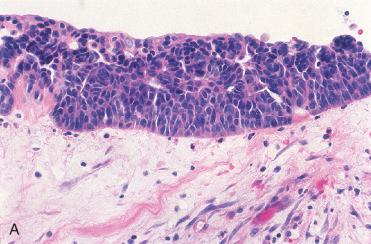
Represents approximately 1% to 13% of all laryngeal carcinomas
More common in men than in women; most frequently seen in the sixth to seventh decades of life
Can occur anywhere in the larynx but most often involves the anterior one third of one or both true vocal cords:
May involve the entire cord
May be bilateral
Frequently associated with an invasive squamous cell carcinoma either lying adjacent to or remote from one another
May exist as an isolated lesion unrelated to invasive carcinoma
Multifocal areas can occur.
Hoarseness is most frequent presenting complaint.
CIS may be associated with invasive carcinoma:
Invasive carcinoma may occur in association with CIS or may be separate from CIS.
Clinically, evaluation is advised to exclude the possible presence of invasive carcinoma.
Risk factors include:
Tobacco smoking (most common) and excess alcohol use:
Alcohol potentiates the effect of tobacco smoking.
Risk of developing dysplastic lesions increases with duration of smoking and/or alcohol use
Role of human papillomavirus in development of carcinoma in situ of the head and neck (other than oropharynx) not proven
Circumscribed or diffuse lesion with a white, red, or gray color and a smooth to granular appearance
Dysplastic process involves the entire thickness of the squamous epithelium without violation of the basement membrane:
Extension into adjacent seromucous glands (particularly in the region of the anterior true vocal cord) may occur and does not constitute invasion.
Squamous epithelium may or may not be thickened.
Cytomorphologic changes include:
Increased nuclear pleomorphism and nuclear size
Loss of cellular maturation and polarity
Nuclear hyperchromasia with irregular nuclear contours
Increased nuclear-to-cytoplasmic ratio
Presence of mitoses in all layers of the mucosa:
May include normal and abnormal forms
Keratosis and dyskeratosis may be present.
In presence of a diagnosis of CIS, the pathologist should liberally section the specimen to rule out the presence of an invasive squamous cell carcinoma.
As previously noted under epithelial precursor lesions (see above), classic carcinoma in situ histologically defined as full-thickness intraepithelial dysplasia is uncommon relative to upper aerodigestive tract intraepithelial keratinizing dysplasias; CIS typically occur in nonkeratinizing dysplasia, which is an uncommon lesion in mucosal sites of the upper aerodigestive tract, especially the larynx and oral cavity:
Keratinizing dysplasias are much more common, and in such lesions full-thickness intraepithelial dysplasia (i.e., classically defined CIS) is uncommon and is not a prerequisite for development of invasive carcinoma.
In setting of keratinizing dysplasia, marked dysplastic alterations may be restricted to basal zone epithelium only, from which invasive carcinoma may develop.
Given such findings, use of diagnostic terms such as “keratinizing severe dysplasia, tantamount to carcinoma in situ” conveys to the surgeon alterations in a lesion that will behave similarly to carcinoma in situ (i.e., irreversible and likely to progress to invasive carcinoma unless adequately treated).
Immunohistochemistry:
No known reliable markers to assist in diagnosis and differential diagnosis
Increased proliferation rates in suprabasal epithelium by Ki67 (MIB1) staining seen in higher-grade dysplasias
Increased p53 immunoreactivity seen in higher-grade dysplasias
p16 not a reliable marker in determining presence or absence of dysplasia in the larynx:
Predominance of keratinizing dysplasia in larynx (often etiologically linked to tobacco and alcohol use) not associated with transcriptionally active virus:
p16 and p21 immunohistochemistry may be present in laryngeal keratinizing dysplasia but does not correlate to the presence of transcriptionally active HPV.
p16 should not be used as definitive surrogate marker of HPV-driven tumors in the larynx.
Wide variation in the literature relative to the incidence of laryngeal CIS progressing to invasive carcinoma:
Discrepant statistics ranging from approximately 3% to as high as 90% reflect inconsistencies in the diagnosis of CIS, which can be a notoriously subjective diagnosis.
Collated incidence of laryngeal CIS progressing to invasive carcinoma is 23% to 27%.
Latent period of 3 to 5 years from diagnosis of CIS to invasive carcinoma
Reactive epithelial changes
Microinvasive carcinoma
No standard treatment; treatment may include:
Vocal cord stripping
Laser surgery
Cordectomy
Radiation
Diagnosis of carcinoma in situ should prompt ablative therapy followed by surveillance for recurrence or progression:
Surgical excision is preferred treatment.
Alternative therapies such as radiation may be employed in selected patients when surgical therapy is not the best option.
Management offers a high cure rate (approximately 75%):
Vigilant follow-up including periodic laryngoscopic examinations should be maintained.
Risk factor modification remains important not only as a primary prevention strategy but to reduce risk of progression to invasive carcinoma.
Treatment failures result from:
Extensive and/or multifocal disease
Associated undetected invasive squamous carcinoma
Extension of CIS to subjacent seromucous glands harboring residual disease following the mucosal stripping:
Particularly true for CIS of the anterior commissure region, where seromucous glands may be located distant from the opening of their ducts and may lie outside area that is stripped
For CIS of anterior commissure additional therapy including laser ablation or irradiation may be indicated.
Definition: Malignant cells that have penetrated the basement membrane and infiltrate into the superficial compartment of the lamina propria.
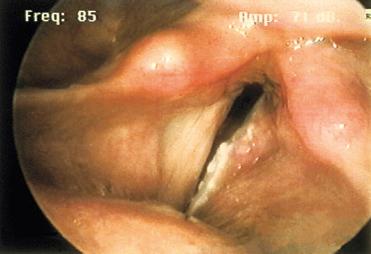
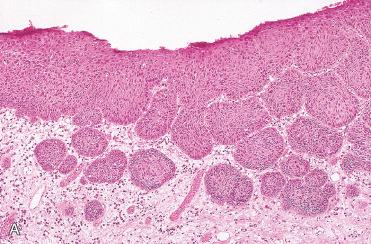
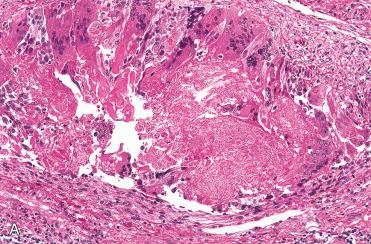
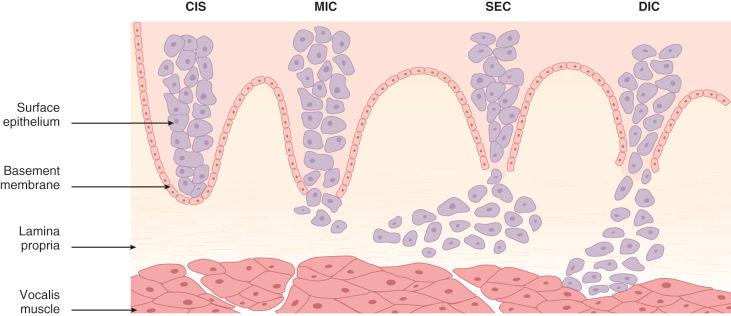
Synonym: Superficially invasive squamous cell carcinoma
Clinical manifestations are similar to those of carcinoma in situ.
In the larynx, full cord mobility is present:
Any dysfunction in vocal cord mobility (fixation) by definition means muscle invasion, which excludes a diagnosis of microinvasive cancer.
Biologically malignant lesion capable of metastasizing either via lymphatic or vascular channels
Similar to carcinoma in situ
Definition of features constituting microinvasion varies in literature:
Presence of scattered malignant cells within the submucosa just below the basement membrane
Presence of malignant cells limited to 2 mm of invasion
Presence of malignant cells within 1 to 2 mm of the basement membrane without angioinvasion
Presence of tongues or discrete foci of malignant epithelium invading through the basement membrane
Invasive carcinoma extending into the stroma no more than 0.5 mm measured from the epithelial basement membrane and without angioinvasion
Represents preferred definition
Regardless of specific definition, diagnosis of microinvasive carcinoma excludes those lesions that are restricted to the surface epithelium or carcinoma in situ (CIS) and those carcinomas that are deeply invasive into muscle and cartilage, and extralaryngeal structures (T2 or greater tumors).
Microinvasive carcinoma can occur in two unrelated phases:
Development from (and as a continuum of) carcinoma in situ:
Typically occurs in a setting of nonkeratinizing dysplasia with full-thickness intraepithelial dysplasia:
Not a common occurrence relative to dysplastic lesions of the larynx (and oral cavity)
Invasion from an epithelium demonstrating dysplastic alterations representing severe dysplasia but lacking full-thickness intraepithelial dysplasia:
Typically occurs in the setting of a keratinizing high-grade dysplasia (i.e., moderate to severe) in which the (micro)invasive carcinoma is seen originating from dysplastic epithelial changes limited to the basal zone epithelium with the remainder of the more superficially located epithelium lacking dysplastic change:
Such invasive carcinomas are referred to as “drop off” or “drop down” carcinoma.
Reinforces the fact that in the upper aerodigestive tract, particularly in the larynx and oral cavity, “classic” carcinoma in situ is not a prerequisite for the development of a (micro)invasive squamous cell carcinoma
In invasive carcinoma:
Tumor nests have an irregular outline with infiltrative borders.
Invasive nests are cytologically malignant, but invasive carcinomas may be extremely well-differentiated with minimal if any malignant cytologic features.
Presence of invasive cancer generally results in a desmoplastic host response that includes edematous change immediately around the tumor nests with granulation tissue and fibrosis:
Identifying tumor-related desmoplasia from reactive stromal changes not straightforward:
There are no clear-cut criteria other than the presence of bona fide malignant cells (in nests or individual cells) to differentiate between tumor-related desmoplasia and reactive stromal changes to assist in a diagnosis of invasion.
In setting of well-differentiated squamous epithelium within the submucosa it can be very difficult if not impossible to determine neoplastic (malignant) epithelium from nonneoplastic squamous epithelium that is reactive and/or represents tangentially sectioned squamous epithelium:
No immunostains or molecular markers available to assist in such a differentiation
In such a scenario a diagnosis of carcinoma may not be possible and a designation of “well-differentiated squamous epithelial proliferation, not further specified” may be required with recommendation for:
Additional deeper biopsies
Conservative but complete excision of the lesion
Keratin granuloma formation in the submucosa represents supportive evidence of (at least) microinvasive carcinoma:
Represents a foreign body reaction to keratin in the submucosa
Appears as relatively well-formed granuloma formation, including the presence of histiocytes and multinucleated giant cells
Keratin material may or may not be identified by light microscopy.
May require cytokeratin immunohistochemical staining (e.g., AE1/AE3, CAM5.2, others) to confirm the presence of keratin-positive material
In the absence of cytokeratin-positive material, a diagnosis of keratin granuloma cannot be rendered.
Histiocytes and giant cells are CD68 (KP1) positive.
Pseudoepitheliomatous hyperplasia
Superficial extending carcinoma (see Fig. 16-27 ):
Early invasive carcinoma that does not extend beyond lamina propria
In contrast to microinvasive carcinoma, which is predominantly an in situ carcinoma with definite but limited invasion into the lamina propria, superficial extending carcinoma shows extensive invasion into (but not beyond) the lamina propria.
By definition there is no invasion into muscle or cartilage.
Associated carcinoma in situ is often present.
May be multifocal
Establishing this diagnosis may be problematic in limited biopsy sampling and may require surgical excision with thorough histologic evaluation.
Limited reports to date and the long-term prognosis remains uncertain
Presence of nodal metastasis in the setting of superficial extending carcinoma may exclude this entity as an “early” carcinoma.
Become a Clinical Tree membership for Full access and enjoy Unlimited articles
If you are a member. Log in here